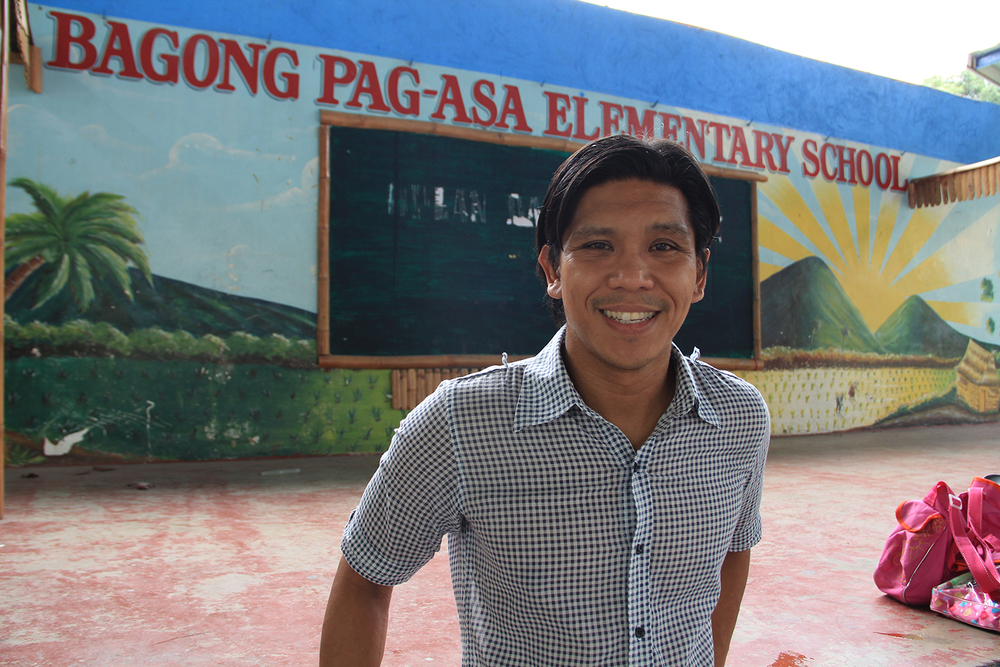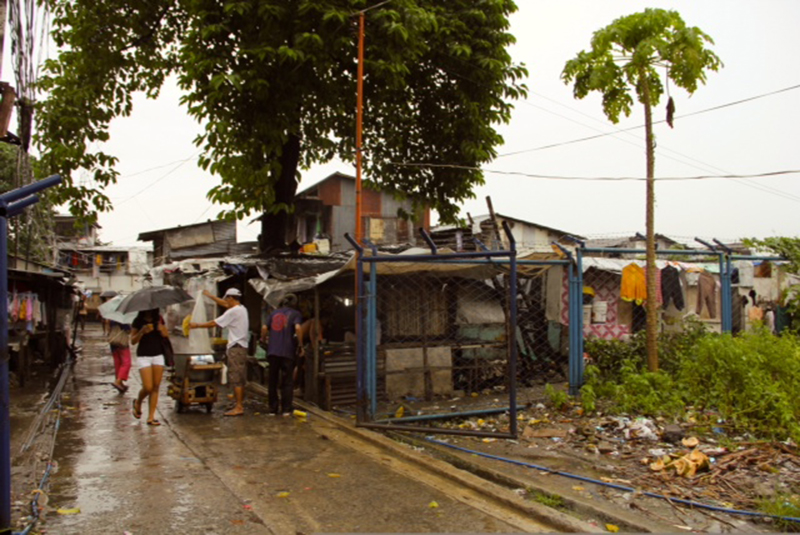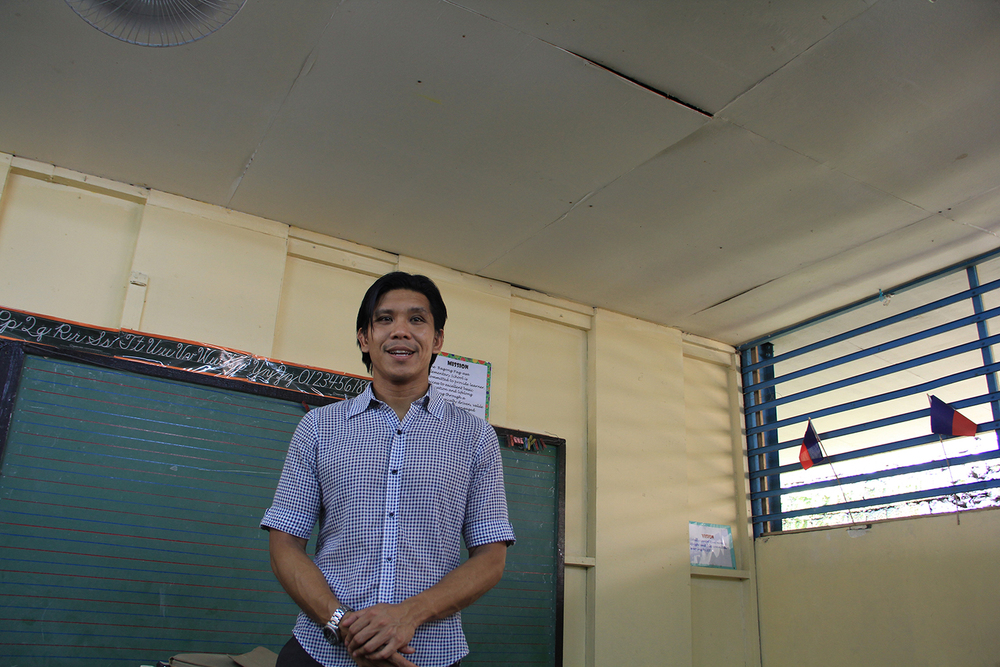A Fil-Am teacher in a Filipino public school
First posted in PositivelyFilipino.com

John Navarra, a Filipino American from Detroit, teaches third grade at Bagong Pag-asa Elementary School. PHOTOS BY AURORA ALMENDRAL
At a classroom in Bagong Pag-asa Elementary School in Quezon City, a crowd of kids sits in small desks, the slatted wood rubbed smooth by years of use. The kids are third graders and are all dressed in navy and white public school uniforms; the girls are in calf-length skirts and loose white blouses with square collars and the boys in creased slacks and polo shirts. It’s the end of the day, and well combed or clipped hair are starting to look unruly, and shirts are coming untucked. All the kids are wiggly.
John Navarra, walks around the room, collecting half sheets of paper with the children’s end-of-day quiz. He offers an incentive: “If you’re finished you can get a book.” The kids scream in excitement and rush to a stack of old, torn books at the front of the room. Navarra’s voice is authoritative, but the most striking thing about it is the sound of his American accent cutting through the kids’ Tagalog chatter.
This is Navarra’s first semester teaching public school in the Philippines. In fact, it’s his first time teaching elementary school, and his first time living in the Philippines. He’s a Fil-Am, born and raised in Detroit, and growing up, he didn’t learn much Tagalog.
He came to the Philippines for the first time as an adult three years ago, and the trip was mostly a blur of white sand beaches, malls and the insides of air-conditioned cars–the usual fare for Fil-Ams escorted here by their parents. But even in the most tightly managed trip, there’s no avoiding the reality of poverty and need in the Philippines.
Navarra decided that he needed to come back, with a purpose. He got a job as a teacher, had a couple of months of training, then jumped in at the deep end.
Bagong Pag-asa Elementary is a public school, which is to say it is overcrowded and underfunded. While some of the kids in his class have Facebook accounts and know about Candy Crush, about half of them come from San Roque, the squatter settlement nearby. Navarra says a couple of his students don’t know how to read yet, and all of them are trying to learn in a hot, outdated classroom where the most advanced technology is a small electric fan mounted on the ceiling.
Growing up going to private schools in Detroit, it’s something that he never even thought to worry about. He says, “All my classrooms were warm enough, or cool enough. I never had to battle the elements while I was in school.” In his classroom now, he’s slapping away mosquitoes, and everyone is sweating. The heat may or may not have anything to do with it, but a fistfight or three breaks out every day.
Navarra thinks of his first-year teachers’ salary–about 18,000 pesos ($440) a month before taxes–as money to buy his kids’ school supplies, with some set aside for his own living expenses, which come down to jeepney fare, pan de sal (roll), peanut butter and a 50-peso lunch at a neighborhood carinderia (eatery).

Entrance to the San Roque informal settlement in Quezon City’s North Triangle. Many of Navarra’s students live here. PHOTOS BY AURORA ALMENDRAL
On his first week of school he took a look around the classroom, then launched an indiegogocampaign to raise $500, the amount he thought he needed to turn the classroom into a learning environment. He met his goal (meager by American standards) in two days. He’ll fix and paint the desks to implement his system of managing the class, which right now is nothing short of chaotic. He’ll buy new books. He’s hoping to get enough copies of the same one so the whole class can read along together. He wants to get a lamp to help light up the dim room, some fans so the kids can concentrate on learning instead of being uncomfortable in the stuffy heat, and some crayons. He’s even hoping to introduce a little technology and buy a projector, because right now, his lessons are handwritten on large sheets of cartolina (poster board) and the waste of paper, he says, is driving him crazy.
The gulf between what he knows about elementary school and what his students deal with every day goes beyond supplies. He didn’t understand why they kick off their shoes as soon as they got in the classroom. Why they fight so much, and where all this energy is coming from.
A visit to San Roque, the North Triangle squatter settlement near the school, helped give him some insight. He was invited to the wake of one of his students’ father, who was stabbed and killed and was lying in state in a rented coffin. Navarra says, “It looked it exactly like I thought it would look.” Narrow alleys, shacks stacked upon shacks, trash everywhere, open sewage, flies buzzing thick along the ground.
That is, until it started to rain. Navarra saw little rivulets forming under his feet. He worried about the mud and sewers. But the kids, they immediately started running outside, barefoot. Screaming, beating each other up and laughing with joy.
One of the hardest things for him has been dealing with the disparity. The San Roque squatter settlement is right up against Trinoma Mall, with its low lighting and pleasantly air-conditioned American chain stores. He visits the houses of rich Filipino families with open compounds and space to spare, while it seems to him every inch of San Roque “is taken up by a piece of trash, or something.”
This class disparity has been the hardest for him to understand. “It just doesn’t sit well with me,” he pauses, “yet, my kids are happy.”
It’s a lesson in Filipino resilience and a reminder that happiness isn’t reserved for people who can afford it.
He says that when it’s hard–and it’s hard all the time–he reminds himself that this is his dream. He’s doing exactly what he wants to do. © For more stories on the Filipino diaspora go to PositivelyFilipino.com https://www.positivelyfilipino.com/
